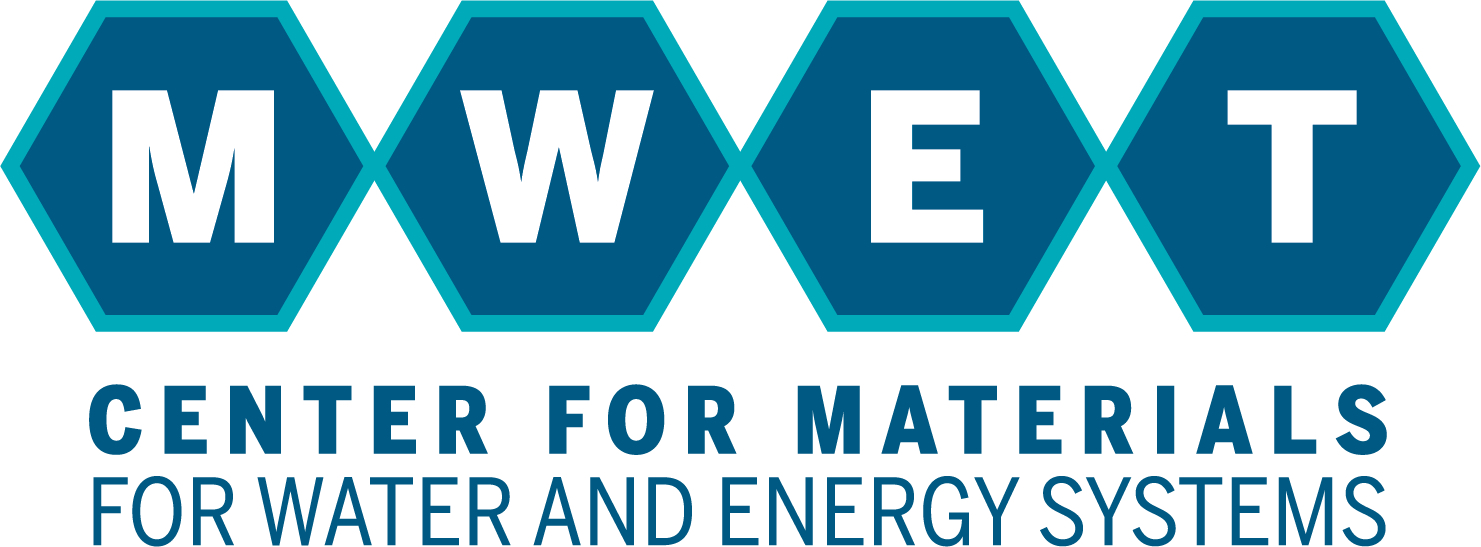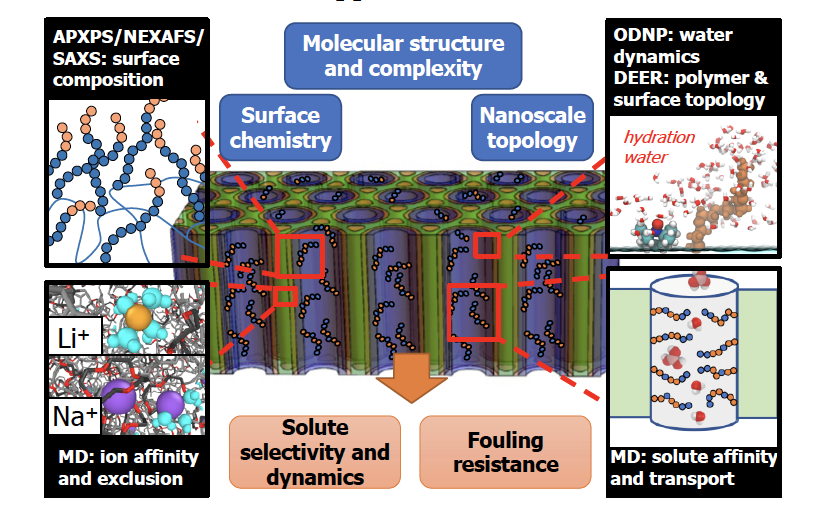
Fig. 2.1. GAP A will integrate state of the art spectroscopic tools to measure surface chemical compositions, including solutes, as well as ODNP to probe water dynamics and double electron–electron resonance (DEER) spectroscopy to quantify surface polymer conformational landscapes. Complementary MD simulations will compute ion and solute affinities/activities at surfaces, as well as water structural, thermodynamic, and dynamic properties.
Structure and Dynamics of Water and Solutes Near Interfaces
GAP A Co-Leaders:
UT Austin: Lynn Katz
UC Santa Barbara: Scott Shell
GAP A Co-Investigators:
UT Austin: Graeme Henkelman
UC Santa Barbara: Rachel Segalman, Craig Hawker
Lawrence Berkeley National Laboratory Advanced Light Source: Ethan Crumlin, Greg Su
Problem Statement:
Our understanding of membrane processes and phenomena, including transport, partitioning, selectivity, and fouling, crucially depends on knowledge of the interactions of water and solutes with membrane interfaces to permit the design of functional surfaces with targeted solute partitioning, fouling resistance, and selective solute transport. Conventional approaches to membrane design, which rely on heuristics to adjust surface hydrophobicity, charge, and roughness, have faced barriers in simultaneously engineering desired antifouling, transport, and permeability-selectivity properties. Even advances using heterogeneous surfaces rely on heuristic interface design. For example, recent efforts suggest that amphiphilic surfaces with hydrophobic and hydrophilic regions may achieve both fouling resistance and release, while other studies suggest that highly hydrophilic zwitterionic surfaces confer strong fouling resistance through the formation of a tightly bound and networked water hydration layer. In both designs, however, the molecular scale chemical and structural properties responsible for fouling resistance are not clear, and hence the optimization and scaleup approach remains heuristic. For example, what property defines a “tightly bound” hydration layer? To effectively inform membrane surface design, we must understand which surface properties define interactions and non-interactions between solutes and surface functional groups at the nm-scale. Relevant interactions, such as hydrogen bonding, electrostatic interactions, van der Waals interactions, etc., will impact hydration layers. Specific chemistries such as charged surface groups can tune hydration water and solute affinity, and surface softness and topology impact local surface energies. Without a foundational understanding of the molecular mechanisms underpinning water, solute interactions/binding, and surface solvation thermodynamics, current membrane design remains bound to Edisonian trial and error approaches.
The objective of GAP A is to develop this critical missing fundamental picture of surface-water and surface-solute water-mediated interactions and identify the specific molecular mechanisms underlying solute affinity (Fig. 2.1 above). We focus on heterogeneous interfaces that remain poorly understood compared to the large body of work that has characterized highly idealized, homogeneous interfaces. Quantitative studies of heterogeneous surface systems will generate design rules for macroscopic and molecular-scale surfaces to:
engineer surfaces with targeted hydration properties,
control solutesurface affinity, and
manipulate water and solute affinity and repulsion, identifying conditions that optimize solute/ion adsorption (fouling-resistance) and desorption (foulant release, membrane cleaning).
Together, these learnings will inform the computational inverse design of surface chemistries with tailored properties. Such knowledge will also have wide-ranging influence on many other challenges, including, for example, the design of active functional surfaces (e.g., antifouling, antimicrobial, biocatalysis), electrochemical energy storage, and biomolecular separations and sensors. These advances provide a molecular framework for understanding the role of hydration in ion transport in GAP B, for incorporation into membranes in GAP C, and for understanding the origins of macroscopic membrane properties in the IF.
Research Questions
We focus on fundamental knowledge gaps in understanding the response of water and solutes to surfaces at the nanometer scale, and the effect of these thermodynamic, dynamic, and structural responses on macroscopic properties of transport and solute affinity/adhesion. We address the roles of chemistry (e.g., hydrophobicity, charge), topology (e.g., polymer brush density), heterogeneity (e.g., mixed composition), and solute identity (chemistry, size, charge). Our questions focus on three levels of understanding:
How does membrane surface chemistry and topology impact the surface hydration water layer and its properties? What is the effect of surface chemistry, flexibility and topology, chemical group composition and spatial presentation on hydration layer water structure, thermodynamics, and dynamics? What defines a “bound” water layer in terms of these properties?
How does surface chemistry and topology tune the affinity, activity, and diffusivity of solutes at the interface? How do specific surface chemistries and compositions impact solute affinity? What structural or dynamical properties of the water hydration layer signal solute affinity and are important to control? How are these behaviors modulated by solute type (e.g., size, hydrophobicity)?
How does surface chemistry and topology impact ion hydration, pairing, activity, and dynamics at the membrane surface? Ions are complex solutes due to their strongly bound hydration shell, ion pairing, and long-range electrostatic interactions. How does ion hydration and pairing change near the membrane surface? How does polymer hydrophobicity, charge density, and hydration impact ion affinity and dynamics? How do complex salt mixtures and high salt concentrations alter surface-ion interactions?
Research Approach
Our unique suite of computational, synthetic, and characterization tools allow us to gain critical molecular insight to surface and interfacial interactions that control solute partitioning, transport, and fouling. GAP A will use the non-porous UMCP platform to rapidly screen the role of functional groups such as amphiphiles, hydrogen bond donors, charges, and zwitterions on water hydration and dynamics and solute interactions (Segalman, Hawker). This platform is further capable of seamlessly integrating experimental probes, and featuring the display of functional groups on various surfaces, micelles or particles in solution. Atomic and molecular scale characterization via simulation (Shell, Henkelman), advanced NMR and EPR techniques (Han), and spectroscopic analysis (Katz, Crumlin) of the thermodynamic and dynamic interactions of these moieties with MFP solutes will integrate with selectivity design in GAP B and macroscopic fouling characterization (Katz, Su) in the IF.
The importance of fouling resistance to membrane performance motivates us to understand the roles of amphiphilicity, local charge groups, and molecular complexity on surface interactions with water and potential solutes. Further, we seek to build bridges between the extensive body of literature addressing marine fouling and molecular scale fouling in membrane technologies:
Recent advances in marine antifouling surfaces suggest that molecularly-patterned amphiphilic materials with both hydrophobic and hydrophilic regions present “ambiguous” surface properties that achieve fouling resistance and release, but the optimal domain length scale remains unclear. To create such patterns, we will leverage Segalman’s work with polypeptoids to make sequences of hydrophilic and hydrophobic monomers Fig. 2.2E).
Zwitterionic surfaces have demonstrated strong fouling resistance attributed to their hydrophilicity. Such surfaces, while less controllable than peptoids, are scalable. To probe the effects of charge diffuseness, we will incorporate zwitterions (Fig. 2.2D) with varying charge density.
2,2,6,6-tetramethylpiperidinoxyl (TEMPO, Fig. 2.2A) is a promising addition for disrupting interface chemistry employed by hard marine foulers. Segalman has shown that co-attachment of TEMPO and PEG to the same backbone results in surface delivery of TEMPO, due to a directing effect by PEG in water, where it is positioned to disrupt interfacial adhesion processes of marine foulers by interfering with oxidative and radical-based reactions. Conveniently, TEMPO also enables complementary Overhauser Dynamic Nuclear Polarization (ODNP) characterization of local water properties using techniques developed by Han.
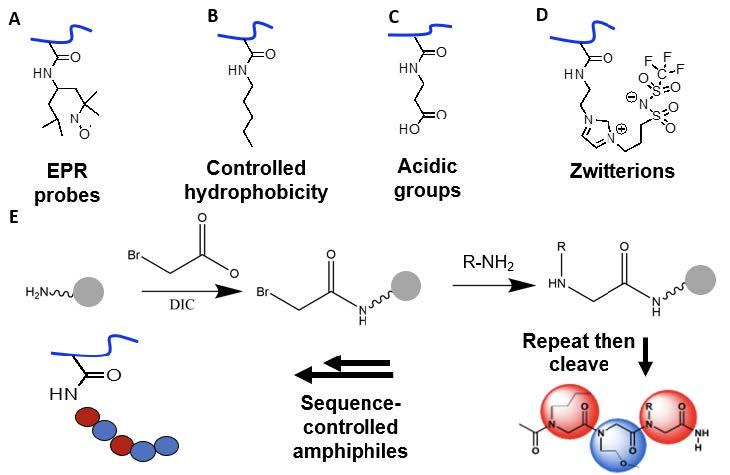
Fig. 2.2. Functionalization of the non-porous UMCP to impart experimental probes (A), hydrophobicity (B), charged groups (CD), and peptoids for sequence controlled amphiphilicity (E).
GAP A, Project #1: Surface Design to Control Hydration Water Structure, Thermodynamics, and Dynamics
What is the precise nature of the hydration layer or “barrier” that has been assumed to impact membrane properties? How can this hydration layer be tuned via surface chemistry? We will use the unique toolset established in our earlier M-WET work to probe interfacial water properties on the molecular scale necessary to understand and ultimately design surfaces to program surface water. It is critical to explore and understand the breadth of functionalities necessary to create programmable surface interactions, to ultimately design membranes that are both selective and robust. Using our materials platform capable of producing multifunctionality (Segalman/Hawker), we will experimentally and computationally quantify the role of chemical and topological surface heterogeneity on hydration water dynamics, structure, and thermodynamics. In particular, we will test the idea that a strongly hydrogen bonded hydration water network (i.e., a highly thermodynamically stable hydration layer) is key to antifouling, by comparing hydrophilic surfaces bearing hydrogen bond donors to hydrophilic surfaces without. Similarly, we will probe the role of charges and zwitterions on hydration and water dynamics. These functionalities will first be displayed on water soluble polymers bearing spin probes to understand their influence on local water dynamics. Next, these functionalities will be displayed on micelles where the hydrophobic core forces the display of the surface groups on molecularly flat surfaces at the nanometer scale. Finally, the same functionalities will be displayed in a hydrogel, formatted as a smooth membrane-like surface and as 100 micron particles suspended in water within a capillary suitable for NMR and X-ray characterization.
With these model surfaces, we will leverage the unique suite of tools established in M-WET to address the critical question of how surface chemistry and topology impact measured structural, thermodynamic, and dynamic properties of the membrane hydration layer. Overhauser Dynamic Nuclear Polarization (ODNP) (developed by Han) will probe hydration dynamics near surfaces (appropriately spin-labelled) in both suspended functionalized hydrogel particles and micelles. Specifically, we anticipate that functional groups including fixed charges and hydrogen bond donors will alter the dynamics of the surrounding water. Measured ODNP water diffusivities will then be directly compared to Shell’s molecular dynamics (MD) simulations that quantify water diffusivities as well as their relationships to water structure (e.g., tetrahedrality, H-bonding) and thermodynamics (e.g., solvation energies/entropies, activity) (Fig. 2.3). Electronic structure and quantum chemical calculations (Henkelman) will capture the role of ions and charged surface interactions with water and will assist in the parameterization of MD force fields. Measured water dynamics will be complemented by depth-dependent chemical composition and water content in analogous thin films via Ambient Pressure X-ray Spectroscopy (APXPS) (Crumlin). Furthermore, Su will use surface-sensitive near-edge X-ray absorption fine structure (NEXAFS) spectroscopy to decipher functional groups and polymer blocks to quantify surface composition in the top few nanometers of a polymer film. GAP A will leverage powerful characterization methods developed within the IF to further probe surface morphology including nanoscale imaging and scattering methods. By systematically linking surface composition to hydration water response, we will discover design rules for programming hydration water properties and hence modulating solute affinity.
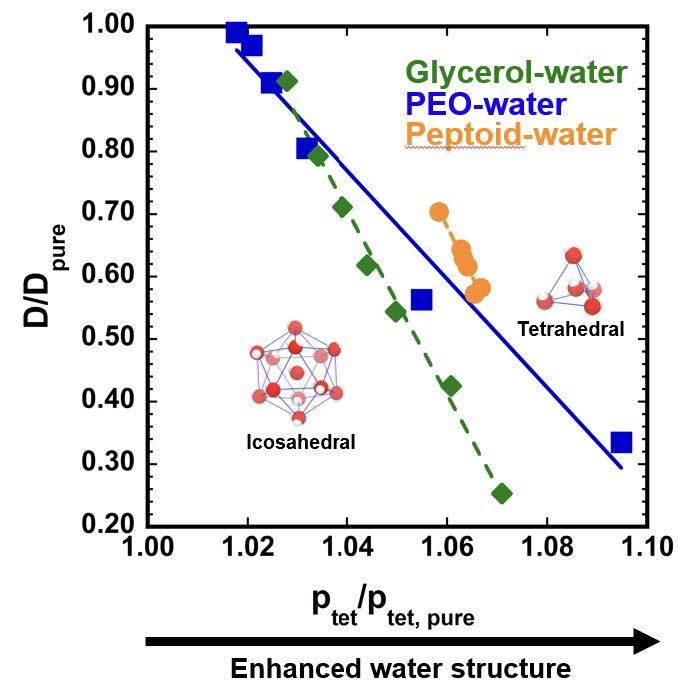
Fig. 2.3. Our prior M-WET work used molecular simulations to establish remarkably strong and persistent relationships between the response of water properties to surfaces and solutes. Here, we show that hydration water dynamics are tightly connected to hydration water tetrahedrality across a range of systems: glycerol-water and PEO-water solutions at different compositions, and peptoids of varied hydrophobic-hydrophilic content and sequence. These results demonstrate that the diffusion coefficient of water is systematically decreased as a function of solute concentration or hydrophobicity, relative to its value in pure water, as the water structure shifts from icosahedral (simple liquid like) to more tetrahedral conformations (water-like). These efforts establish an exciting basis for relating water structural response to functional properties in a predictable manner and for using ODNP measures of local diffusivity and other experimental probes to assess hydration water shifts relevant to solvent affinity.
GAP A, Project #2: Molecular Determinants of Solute Affinity at Heterogeneous Interfaces
Our second focus is understanding how surface chemistry and heterogeneity impact the thermodynamic affinity of solutes to membrane interfaces. We will use the same model surfaces proposed in Project 1 to experimentally and computationally characterize the affinity of MFP solutes to them, establishing a rational framework for engineering solute affinity and repulsion at membrane interfaces. We hypothesize that the hydration water response to a surface (e.g., hydration water structure, dynamics) offers key signatures of solute affinity. Thus, we will couple the hydration water insights from Project 1 to solute affinities for a range of MFP solutes, focusing in particular on several important solute families: (1) aromatics (benzene, toluene, phenol, benzonitrile, xylenes, naphthalene, dioxane) that represent contaminant chemistries of concern and that allow us to systematically modulate hydrophobic interactions, (2) linear aliphatics and alcohols that appear in oil foulants and can probe chain length variations, (3) short polypeptides as protein mimics with varied hydrophilic phobic composition, (4) borates and arsenous acid that form molecularly small, neutral species that are difficult to separate, and (5) silicates that aggregate proteins and NOM on membrane surfaces with inter-solute interactions that apparently increase fouling beyond the sum of the two foulants.
We will characterize interfacial solute adsorption as a function of surface chemistries in functionalized hydrogels using a unique workflow: APXPS measurements (Crumlin) will measure precise, depth-dependent concentrations of solutes at surfaces with varying levels of hydration (Fig. 2.4). Su will use NEXAFS spectroscopy at different detection modes with varying surface sensitivity to unveil solute and polymer composition as a function of depth, while Katz will characterize solute affinity (adsorption) in the bulk membrane interior for a variety of background water qualities ranging from simple single solute systems of varying ionic strength to multi-solute systems. This work will be complemented by resonant soft x-ray reflectivity, a unique capability at ALS, which leverages the same energy-resolved chemical sensitivity of NEXAFS spectroscopy and can quantify the depth-resolved composition of specific solutes in a polymer film with nm resolution. Simultaneously, ODNP measurements by Han, both at the surface of an analogous hydrogel particle and in the interior, will report on changes in hydration shell dynamics in response to solute adsorption. Simulations by Shell will simultaneously compute the spatially-dependent solute excess chemical potential (Fig. 2.4a)and activity coefficient, from bulk water, to the membrane interface, and then in the membrane interior. The key observables to compare are the surface partition coefficient K and concentration profile c(z). Shell’s computational inverse design methods combining simulations, machine learning, and optimization algorithms will be used to identify membrane surface chemical compositions or peptoid sequences that minimize surface affinity of representative small foulants.
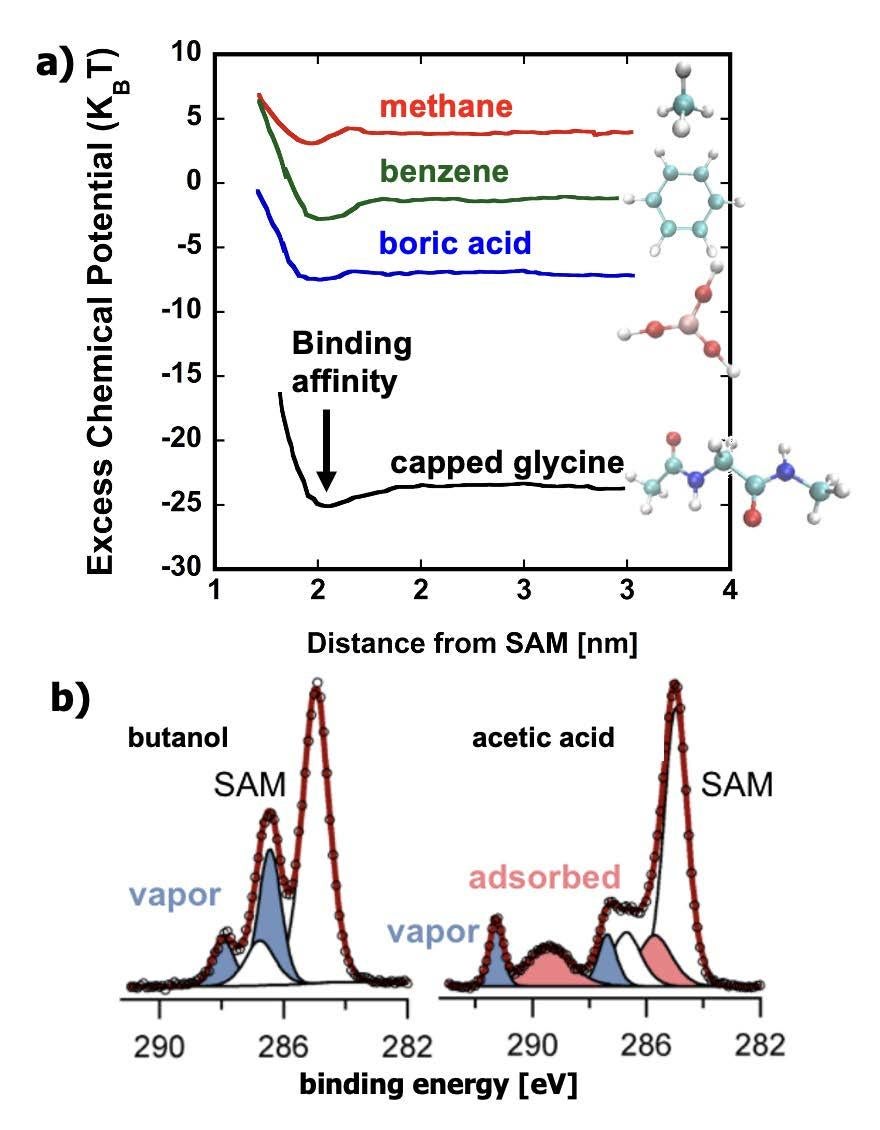
Fig. 2.4. (a) Simulations measure affinity (excess chemical potential / activity) of a range of MFP solutes to model SAM surfaces. (b) APXPS experimentally quantifies adsorption of solutes (butanol, acetic acid) to SAM surfaces.
GAP A, Project #3: Ion Hydration, Thermodynamics, and Dynamics in Networks and at Interfaces
Ions are especially complex solutes due to their strongly bound hydration shell, ion pairing, and long-range electrostatic interactions. Therefore, Project 3 in GAP A focuses on a better understanding of the impact of aqueous ion interactions (ion hydration, ion pairing) and functionalized membrane material properties (water density/hydrophobicity, charge density) on ion affinity, dynamics, and membrane electrostatics (e.g., Donnan potential). We have previously shown the importance of hydration and ion-pairing on membrane selectivity for ionic solutes, such as Na+/Mg2+ and NaCl/Na2SO4 in Nafion. Here, we propose to elucidate the impact of surface chemistry on ion hydration and ion pairing. In situ APXPS can quantify the Donnan potential and ion transport as a function of ionic strength, thus enabling us to refine predictive models of ion selectivity for varying functional groups. X-ray absorption fine structure spectroscopy (NEXAFS/EXAFS) will help reveal local environments around specific ions and nearest neighbor coordination shells.
Utilizing the platform shown in Fig 1.2b and 2.2, we will incorporate functional groups such as sulfonate, carbonate, imidazoles, phosphonates, amines (primary, secondary, and tertiary), and zwitterions into carefully controlled hydrogel films and micelles functionalized with similar functional groups and then evaluate their relative affinity for a range of cations and anions that vary with respect to their size, charge and propensity for hydration and ion-pairing, including alkali metals (Na+, Li+, Cs+), alkaline earth metal ions (Mg2+, Ca2+, Sr2+), transition metals (Cu2+, Zn2+, Cr3+), halides (F-, Cl-, I-), and oxyanions (e.g., nitrate, phosphate, arsenate, sulfate, borate, or chromate). To determine the solute affinity of each ion/functional group (Katz), both concentration and ionic strength will be varied to assess the impact of ionic concentration on hydration and solute affinity in hydrogel films characterized via spectroscopic and macroscopic tools in the IF. Additionally, we will conduct macroscopic studies of material properties (e.g., water and ion permeation and ionic conductivity) to fully characterize them in conjunction with the IF, using crossflow rejection experiments, concentration gradient-driven permeation experiments, electrically driven conductivity measurements, and macroscopic water uptake. Using these composite data together with corresponding molecular dynamics simulations, we will quantify the relative impacts of functionalization and charge density on water dynamics at/near functional groups. This information will address a fundamental question regarding the importance of water dynamics on the competition between ion hydration and ion pairing with respect to solute affinity for the interface bearing the functional group.
We will use in situ APXPS characterization of these materials (Crumlin) to probe the surface chemistry that drives solute (e.g., ion) activity within the membrane and gain atomistic understanding of macroscopic phenomena (Fig. 2.5). We have developed a new flow cell geometry that allows us to change the liquid on the backside of the membrane to enable the direct observation of ion, solute, and solvent transport through the membrane as a function of time. The true power of this capability is that we can now observe transient changes in macroscopic properties (e.g., Donnan potential) for varying molecular level surface chemistry, allowing us to simultaneously explore both thermodynamic and kinetic properties. We aim to further illuminate how electrical potential distributions at membrane/solution interfaces are influenced by size, charge, and chemical interactions among ions. We will expand this approach to study complex ions such as sulfates, phosphates, and nitrates, which can undergo ion pairing, thus influencing their degree of interaction within the membrane. Because these properties play a critical role in influencing the Donnan potential, it will be possible to use results from this matrix of experiments to help reveal sources of nonideal behavior (e.g., activity coefficients) in membranes. These studies will be complemented by ODNP measurements (Han) on micelles bearing fixed charges (as described in Project 1) to understand the role of ions such as alkali metals, alkaline earth metals, and halides as they compete with hydration water to interact with the membrane functional groups (e.g., fixed charge groups). Mixtures of mono- and divalent salts (1:1, 1:2 and 2:1 ratio of anion:cation) with varying propensities for ion pairing will also be studied. MD simulations by Shell will provide a powerful tool for understanding ion surface binding, mechanisms of diffusion, diffusivities, ion-pairing, and ion activity profiles and, importantly, how these properties vary with both the anion and cation species and membrane structure. However, a limitation of our current simulations is that they are based upon fixed-charge, non-polarizable force fields. As M-WET moves forward, we will include Henkelman for his expertise in density functional theory (DFT). While more computationally expensive, DFT is remarkably accurate for the cost and requires no adjustable parameters, allowing us to connect our current strong capabilities in continuum and molecular-scale modeling to atomic-scale interactions governed by quantum mechanics. DFT simulations provide a good description of variable chemical bonding, charge states, and polarizability, which is especially important for ions. DFT will also provide validation for the accuracy of our MD simulations, by comparing predicted interactions between the two for representative small (<1000 atoms) systems. When discrepancies are found, we will use machine learning (ML) to fit corrections to MD force fields using the Henkelman group software package pyamff, providing improved accuracy while maintaining MD’s ability to simulate over long time and length scales. More broadly, the Henkelman group will provide DFT and ML potential capabilities throughout the other GAPs. These collective efforts will establish basic molecular pictures of how membrane surfaces impact ion behaviors, establishing a fundamental thermodynamic and dynamic framework to support efforts in GAP B.
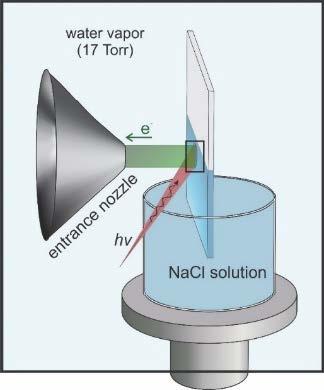
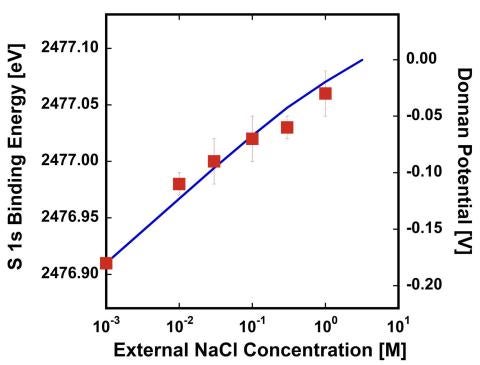
Fig 2.5. APXPS (red data points) provides the first direct measurement of the Donnan Potential at a membrane surface, for NaCl sorbing into a cation exchange membrane (CR-61), achieving quantitative agreement with predictions from the Donnan/Manning model (blue line)
Research Highlights - GAP 1 (M-WET project years 2018 to 2021)
The Donnan Potential Revealed
Using tender-APXPS, we have directly measured the Donnan potential at the membrane/solution interface for CR-61 membranes equilibrated with NaCl and MgCl2 solutions.
Effects of Amphiphilic Polypeptoid Side Chains on Polymer Surface Chemistry and Hydrophilicity
In situ ambient pressure X-ray photoelectron spectroscopy (APXPS) reveals that polypeptoid-modifications can alter polymer interactions with water and instigate surface restructuring.
Sequence modulates polypeptoid hydration water structure and dynamics
Demonstrated that changes in both the number and placement of nonpolar monomers in the polypeptoid sequence affects both local water structure and dynamics and that such effects are correlated.
Quantifying polypeptoid conformational landscapes through integrated experiment and simulation
Proposed and cross-validated experimental and computational workflows to analyze structural populations of disordered polypeptoids.
Molecular Orientation and Structure in Model Ultrathin Layer-by-Layer Polyamide RO Membranes
Near Edge X-ray Absorption Fine Structure (NEXAFS) spectroscopy reveals molecular orientation varies with film thickness in layer-by-layer grown model RO membranes.
Simulations Reveal Complexity of Solute Affinity to Surfaces
Phase-field simulations demonstrate that mass-transfer-driven spinodal decomposition, thermal fluctuations, and structural arrest are essential to the formation of asymmetric polymer membranes in the Nonsolvent-Induced Phase Separation process.
Quantifying Polypeptoid Conformational Landscapes Through Integrated Experiment and Simulation
Proposed and cross-validated experimental and computational workflows to analyze structural populations of disordered polypeptoids.
End-to-end Distance Measurements of Aqueous Low-Molecular-Weight Polyethylene Oxide
Fully resolved end-to-end distance probability distribution measurements and simulations for aqueous polyethylene oxide (PEO) establish semi-flexible, excluded volume polymer.
Directly Probing Polymer Thin Film Chemistry and Counterions Influence on Water Sorption
Tender APXPS results provide direct quantification of hydration on polymers in situ at the molecular level.

